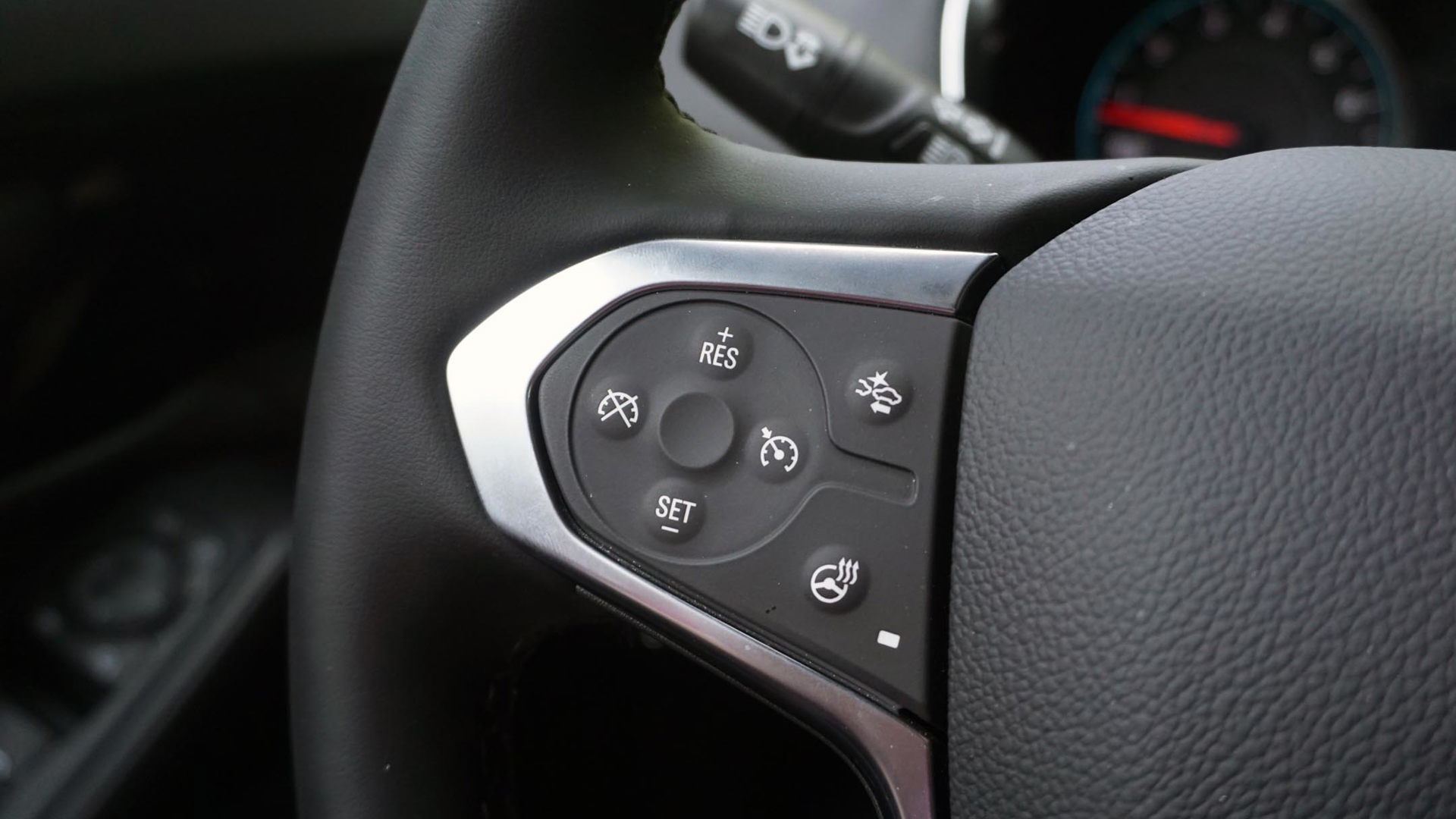 AutoTrader SCORE
AutoTrader SCORE
-
STYLING7/10
-
Safety8/10
-
PRACTICALITY10/10
-
USER-FRIENDLINESS10/10
-
FEATURES9/10
-
POWER8/10
-
COMFORT8/10
-
DRIVING FEEL9/10
-
FUEL ECONOMY6/10
-
VALUE6/10
There’s a new version of the three-row Traverse on its way that Chevrolet promises will deliver “more SUV-like proportions” to go with a rugged new off-road trim.
It certainly looks appealing, especially with that Z71 package, but for all that separates the upcoming model from its predecessor, they share a rather important trait: space. Lots of it. Since its introduction some 15 years ago, this Chevy has offered noticeably more interior room than a typical three-row like the Nissan Pathfinder while retaining the disposition and drivability of a smaller vehicle.
That’s as true today as it inevitably will be when the next-gen model arrives some time next year, which bodes well for the 2023 Chevrolet Traverse as a more immediate option. However, the trade-off is an SUV that feels a little outdated overall.
Practicality: 10/10
Perhaps the biggest attraction of the Traverse – as well as its corporate cousin, the Buick Enclave – is all the space it offers in spite of similar proportions to the average SUV this size. While their overall lengths are almost identical, the Traverse’s wheelbase measures 3,072 mm (120.9 in) compared to 2,900 mm (114.2 in) for both the Pathfinder and the Hyundai Palisade.
The result is noticeably more room inside, particularly for third-row occupants. The Traverse also benefits from considerably more cargo room than its contemporaries, with a generous 651 L behind the third-row seats and 1,637 L with them folded. There’s also a reasonable amount of small-item storage throughout the cabin, including a hidden compartment behind the infotainment screen. Meanwhile, every trim but the cheapest one comes with a trailer hitch and transmission oil cooler, and is rated to tow 2,268 kg (5,000 lb).
User-Friendliness: 10/10
Beyond the outright space offered by the Traverse, its low step-in height and massive door openings are among the hidden gems here that the vast majority of its rivals go without. Accessing the cabin is almost car-like, which is especially convenient for children or those with mobility challenges.
Once behind the wheel, the low-cut hoodline and huge windows afford excellent views of what’s happening outside. It’s only the rear headrests – plus any occupants using them – that obstruct visibility out the back, but then the available camera-based rearview mirror sees to that by providing a live look behind the vehicle.
The tiny-looking touchscreen is a great example of how far in-vehicle displays have come in the five years since this second-generation Traverse was introduced (the standard screen in the upcoming version is more than twice the size). On the bright side, the eight-inch unit here is mounted low on the dash to minimize distraction, while the software it runs is outstanding and offers a smartphone-like simplicity. Input response is sharp, while the graphics are crisp and well defined. Otherwise, the cabin is full of physical controls for climate, audio, and more.
Styling: 7/10
Beyond the small screen, the interior is beset with plastics that look and feel a little low-grade. The stuff used for the window switches and door pulls, as well as the controls on the centre stack, is almost like the placeholder plastic from a pre-production vehicle. More generally, the cabin is rather nondescript and lacks much in the way of character. But then it feels fairly durable and should handle the rigours of family life with relative ease.
As far as overall presence goes, the Traverse is a little anonymous next to the Palisade or even the Kia Telluride, which plays up its proportions with a big and block-like design. This Chevy almost looks long and lean by comparison, while this tester’s black badging set against metallic black paint ($495) only adds to the perception of inconspicuousness.
Comfort: 8/10
Despite being underpinned by conventional coil springs and dampers, the Traverse coasts along with comfort and composure. In fact, ride quality is among its finest attributes – and it might be among the finest in the segment. The seats, however, could use some work, with a general stiffness that led to some leg discomfort after only about an hour behind the wheel.
Driving Feel: 9/10
Beyond its outstanding ride quality, this three-row has the shockingly rare distinction of offering properly proportionate steering feel. Far too many SUVs this size have lifelessly light systems that betray their heft, but not here. It’s not as if the Traverse is a chore to drive, either – simply that the effort required to change directions makes sense given its size and mass.
Better still, it’s not top-heavy or tippy the way some softly sprung sport utilities are, staying firmly planted even when tackling highway on-ramps with a bit too much speed. It remains manageable and approachable no matter the scenario, just as a family hauler should.
Features: 9/10
Even the cheapest Traverse comes with active noise cancellation and a subscription-based Wi-Fi hotspot, neither of which are common in the segment, while the front seats are heated and the automatic climate control system is of the tri-zone variety. There are also six USB ports throughout the cabin, two in each row, while the Android Auto and Apple CarPlay connections are wireless, and most trims get an eight-inch touchscreen (the base version relies on a seven-inch unit). Pricier trims, including the RS version tested here, get more good stuff like an upgraded stereo with 10 speakers and a heated steering wheel, while the top two trims add heated second-row seats and ventilated front ones.
Safety: 8/10
On the advanced safety front, forward collision warning with pedestrian detection and automatic emergency braking is standard, as is lane-departure warning and -keeping assistance, automatic high-beam control, and a so-called teen-driver system that can limit features like stereo volume and provide a detailed driving report. Meanwhile, blind-spot monitoring with rear cross-traffic alert and adaptive cruise control come with all but the two cheapest trims.
The various systems work as expected, although the forward collision warning is rather sensitive, beeping and flashing at the sight of street-parked vehicles in the city. Otherwise, the adaptive cruise maintains a reasonable distance from preceding traffic and is quick to get back to a preset speed after slowing down.
Power: 8/10
With the 2024 Traverse switching to turbocharged four-cylinder power, it’s the end of the line for this 3.6L V6. While output doesn’t exactly jump off the page, with 310 hp and 266 lb-ft of torque, it smoothly and reliably gets to the ground with the help of a nine-speed automatic transmission and selectable all-wheel drive system. The transmission in particular is a treat, smoothly – and quickly – responding to situations like passing by dropping a gear in order to spike the revs for near-peak torque when it’s required.
Fuel Economy: 6/10
The ability to disengage the all-wheel drive system is something of a novel feature, allowing the Traverse to run in front-wheel drive to save fuel, although it also means it must be manually switched back for extra traction. (Most modern systems simply do this automatically.) Regardless, this Chevy won’t be winning any awards for around-town efficiency.
Officially, it’s rated to return 13.6 L/100 km in the city – a number that wasn’t touched during this test. The first 60 km or so saw an indicated average of nearly 15.0, although that number fell dramatically with more time spent on the highway, with a final fuel tally of 10.0 L/100 km across more than 630 km. That’s better than the 11.8 the Traverse is rated for, which is slightly worse than most SUVs this size.
Value: 6/10
With prices on the rise across the industry, the entry-level Traverse LS is a relative bargain at $44,348 before tax (but including a non-negotiable freight charge of $1,995). That’s nearly $8,500 less than the cheapest Telluride that rings in at nearly $53,000 before tax. Similarly, the cheapest Palisade is $51,474 before tax but including freight. Both boast more features but aren’t even close to as budget-friendly.
The next-in-line LT trim stays below the $50,000 mark before tax, but the rest of the four trims are well north of that, with the range-topping High Country cresting $65,000. Meanwhile, the RS version tested here had a sticker price of $57,373 after a handful of options and extras were added.
The Verdict
In the end, there’s nothing wrong with waiting for the new Traverse to get here sometime next year, but just remember the growing pains that often come with new vehicles. An entirely new powertrain, plus that oversized infotainment system, await early adopters who could be in for some headaches. The 2023 Chevrolet Traverse isn’t nearly as flashy or modern as its successor promises to be, but those looking for outright space and satisfying drivability won’t do much better.
| Engine Displacement | 3.6L |
|---|---|
| Engine Cylinders | V6 |
| Peak Horsepower | 310 hp @ 6,800 rpm |
| Peak Torque | 266 lb-ft @ 2,800 rpm |
| Fuel Economy | 13.6 / 9.6 / 11.8 L/100 km cty/hwy/cmb |
| Cargo Space | 651 / 1,637 / 2,781 L behind 3rd/2nd/1st row |
| Model Tested | 2023 Chevrolet Traverse RS |
| Base Price | $52,653 |
| A/C Tax | $100 |
| Destination Fee | $1,995 |
| Price as Tested | $57,373 |
|
Optional Equipment
$2,625 – Side steps, $995; Floor liner package, $575; Mosaic Black Metallic paint, $495; Black lug nuts, $365; Engine block heater, $195
|
|





































